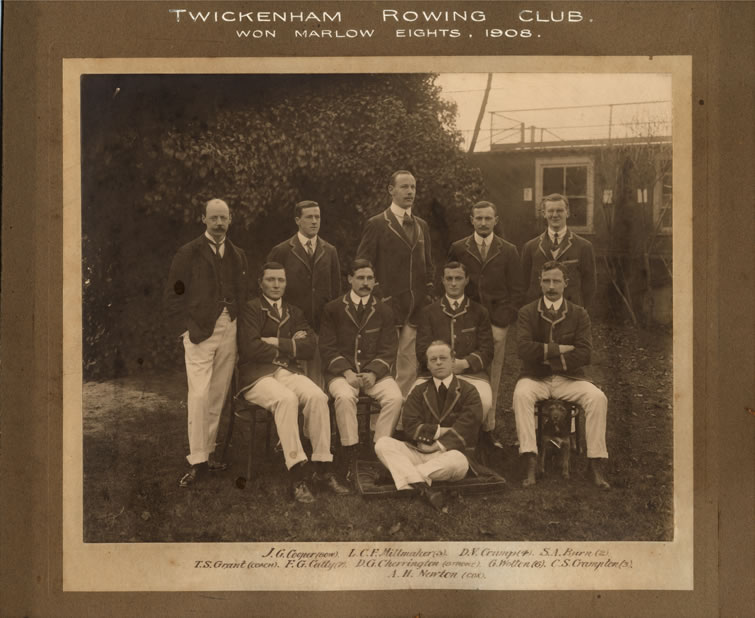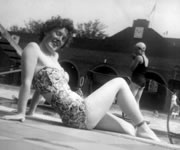Twickenham Rowing Club

THE FRENCH CONNECTION 1860 – 1899
Louis Philippe I was elected King of the French in 1830, but in 1848 he sought exile in England, living here as Comte de Neuilly until his death in 1850. There were six sons and four daughters by his marriage to Marie Amelie.
In 1864, York House, Twickenham, became the family home until the turn of the century.
Philippe I's fifth son was Henri, Duc D'Aumale (1822 ‐ 1897) and the Club's first President from 1860 to 1897.
Aumale's eldest brother was Ferdinard, Duc D'Orleans, who died in an accident in 1842. He was succeeded by his elder son, Philippe VII, Comte de Paris (1838 ‐ 1894), who was the donor of the Club's freehold land in 1876. The Comte de Paris was a figure of some political importance. On the death of the Comte de Chambord in 1883, he became King Philippe VII, pretender to the French throne.
Philippe VII's son, Philippe VIII, Duc D'Orleans (1869 ‐ 1899) became the Club's second President from 1898 to 1899, on the death of his great uncle, Duc D'Aumale.

CLUB HISTORY
1860 ‐ 1876
Twickenham Rowing Club was founded on 26th July 1860 and is jointly (with Thames RC) the third oldest of the rowing clubs on the Thames.
The first boathouse was built in 1861/62 as a floating structure and was moored at some point off Twickenham Ait (Eel Pie Island). It cost £295 and was fully paid for out of ordinary income, by 1866.
Eel Pie Island was earlier called Twickenham Ait and before that The Parish Ait. Earlier the island was actually three aits. In 1889 it was proposed to build a bridge to the island but that didn't happen until 1957.
In 1864 arrangements were made with the Twickenham Literary Society whereby their Reading Room in King Street could be used as a clubroom by members. By March 1866 the boathouse contained:
• 1 Cutler eight,
• 2 Gig eights,
• 2 Cutler fours,
• 2 Gig fours,
• 1 Skiff and
• 1 Punt.
The boathouse was then damaged by ice, and sank. On its repair in 1866/67 fenders were fitted to ward off ice and a bathroom provided.
In 1870/71 a Dressing Room for members was hired at George Colless Inn for a rental of £17 per annum. Later they moved to the Queens Head at £15 per annum.
1871/72 saw a further deterioration of the boathouse and a new bottom was fitted at a cost of £127.
Early in the winter of 1872/73 a severe storm caused the boathouse to sink again and it remained submerged for some months before repairs could be made.
In 1876 when the Club became the owners of its present site, the boathouse was put ashore and was finally sold in 1882/83 for £32. The Thames Conservancy provided the ballast to raise the ground level where it rested.
1876 ‐ 1883
In April 1876 the Hon. Treasurer, C.J.Millett wrote to members informing them that H.R.H. Le Comte de Paris had generously presented the Club with the freehold of a piece of ground on Twickenham Eyot, the conveyance being subject to an unexpired lease. It would be necessary for the Club to treat with the Lessee for a surrender. The Lessee was E.A.Bowen with a 21 year lease granted on 1st July 1865 at a rental of two pounds and ten shillings per annum.
A Deed of Gift dated 6th August 1876 between W.M.Coulthurst and H.L.Antrobus (Partners in Coutts & Co, Bankers and Trustees of the Orleans family interests) formally conveyed the land to the Trustees of the Twickenham Rowing Club, subject to the unexpired lease. Those first Club Trustees were C.D.Millett, B.T.White and R.M.Thrupp, and they and their successors have absolute discretion as to the holding of the property or to its sale for the benefit of the Club as they deem fit and proper.
On 12th March 1877 a Special Committee was set up to consider plans for a new boathouse having on estimated cost of £600. For various reasons some two years were to pass before matters were finalised.
On 4th December 1878, E.A.Bowen surrendered his lease of the ground so giving the Club unencumbered title and by March 1880 the Committee considered that sufficient funds were in hand, together with a £300 mortgage to commence building.
The afternoon of Saturday 13th March 1880 saw Mrs.Powell, wife of the Hon.Secretary performing the ceremony of driving the first of the 39 piles of the new building with some of the leading members assisting at the windlass. The Architect was W.T.Mann, Essex Street, Strand and the Contractors C.Saunders & Son of Shepherds Bush, the cost £855.
In 1882/83 a Lean‐to was added for the housing of members' private boats, and a cesspool was constructed, total cost £95.
1883 ‐ 2003
During these years the major changes to the boathouse and its facilities have been:
• 1927/28 Connected to mains water. Previously water was pumped from the river.
• 1928/29 Foundations strengthened. The original piles were cut off between the ground and lower floor and brick plinths inserted.
• 1929 Rowing Tank excavated by members under the supervision of K.R.Craig and B.A.Lansdown. The original seating was provided by cutting in half an old four.
• 1930 Tank building erected.
• 1932 Main roof covered in asbestos sheeting.
• 1949/50 Brick and concrete Lean‐to built to replace the original wooden rear wall and to give additional support to the main structure as well as to provide greater shower and toilet facilities. Cost £986.
• 1957 Bridge built connecting island to Twickenham embankment.
• 1958 Right of Way to central island pathway established when Thames Launches had fenced off our previous access.
• 1964 Oil fired water heating installed, cost £204.
• 1983 Club connected to mainland drainage.
• 1993 Connection to gas main, superseding oil fired system.
• 1993/94 Tank building extended to provide weight training area.
• 1997 The club is awarded a lottery grant which enables a further extension to the boathouse, to house fours and quads, to be built next to the lean‐to.
• 1998 The footbridge to Eel Pie Island is replaced after damage by British Gas renders it unsafe. A ferry service for Island residents is run to the club and a ramp and pontoon built, to accommodate the ferry and prevent damage to the hard.
Images copyright Twickenham Rowing Club


